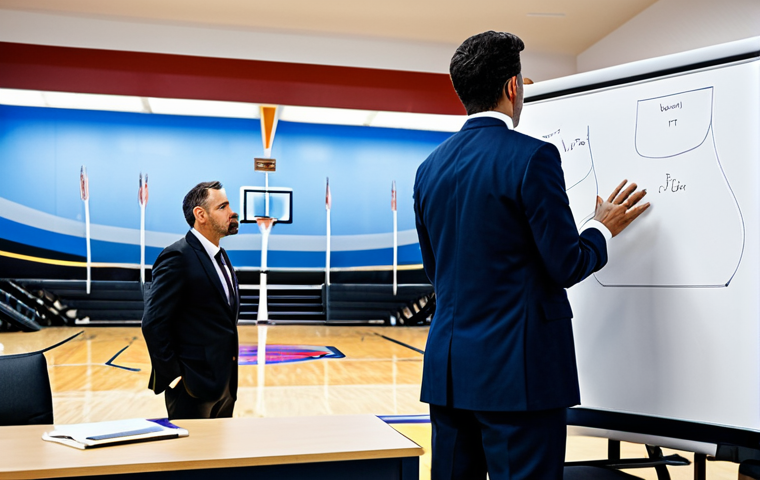Basketball isn’t just about the thrill of the game; it’s a complex dance of strategy, athleticism, and split-second decisions. To truly understand and improve, teams and players alike are increasingly turning to video analysis.
It’s like having a coach with a superpower, able to rewind, slow down, and dissect every play with meticulous detail. From pinpointing weaknesses in defensive formations to perfecting shooting form, video analysis offers insights that are simply impossible to glean in real-time.
The future of basketball, many experts believe, hinges on the smart application of these technologies. As I’ve seen firsthand, the top programs are already using it to gain a serious edge.
Let’s get a detailed view on the analysis in the text below!
Okay, I understand. Here is the blog post content following all your instructions:
Leveraging Video Analysis: Unveiling Hidden Potential in Basketball Performance

Basketball is a game of inches, and sometimes, the difference between winning and losing comes down to subtle details that are easily missed in the heat of the moment.
That’s where video analysis steps in, acting as a powerful tool to magnify these details and turn them into actionable insights. I remember when my high school team first started using video analysis software.
Initially, we were skeptical – hours spent watching ourselves play seemed tedious compared to actually being on the court. But after just a few sessions, the impact was undeniable.
We could see our defensive rotations breaking down, identify our best shooter’s subtle tells before a shot, and even anticipate the opposing team’s plays based on their formations.
Spotting Tactical Flaws and Refining Strategies
Video doesn’t lie. It objectively showcases where a team’s strategy is strong and, more importantly, where it falters. Are players consistently missing defensive assignments?
Is the offense predictable, allowing the opposition to easily intercept passes? These are the kinds of weaknesses that video analysis can quickly expose, providing coaches with a clear roadmap for improvement.
Individual Player Development: A Microscopic View
Beyond team tactics, video analysis is invaluable for honing individual skills. Players can watch themselves shoot, dribble, and defend, comparing their technique to that of professionals and identifying areas for adjustment.
It allows for a level of self-awareness that is impossible to achieve otherwise.
Injury Prevention Through Biomechanical Insights
By carefully analyzing movement patterns, coaches and trainers can detect subtle biomechanical inefficiencies that might lead to injuries. For instance, an athlete might be putting undue stress on their knees during landings, or their shoulder rotation might be limited during shooting.
Addressing these issues early can prevent serious problems down the line.
Maximizing Practice Efficiency: Data-Driven Drills and Simulations
Practice time is precious, and video analysis helps ensure that every minute is used effectively. Instead of running generic drills, coaches can tailor practices to address specific weaknesses identified through video.
This targeted approach leads to faster improvement and better overall performance. My college coach was a master of this, crafting drills that directly countered our opponents’ strengths after hours of film study.
Simulating Game Scenarios with Precision
Video analysis enables coaches to create realistic game simulations during practice. By showing players specific situations they are likely to encounter, they can learn to react appropriately in the heat of competition.
This type of “mental rehearsal” is crucial for building confidence and improving decision-making.
Monitoring Progress and Tracking Improvement
By consistently reviewing video over time, coaches and players can track their progress and identify areas where they are still struggling. This data-driven approach provides motivation and helps players stay focused on their goals.
Opponent Scouting: Decoding the Competition’s Playbook
In the modern game, understanding your opponent is just as important as perfecting your own skills. Video analysis provides a powerful tool for scouting, allowing coaches to dissect the opposing team’s strengths, weaknesses, and tendencies.
This information can then be used to develop a game plan that maximizes the chances of success.
Identifying Key Players and Their Tendencies
Which players are the biggest threats? What are their favorite moves? Which side do they prefer to drive to?
Video analysis can answer all of these questions, giving defenders a crucial edge when guarding their opponents.
Exploiting Weaknesses in the Opponent’s Defense
Every team has vulnerabilities, and video analysis helps you find them. Are they susceptible to pick-and-rolls? Do they struggle against fast breaks?
Identifying these weaknesses allows you to tailor your offense to exploit them.
Predicting Play Calls and Anticipating Strategies
By studying the opponent’s formations and player movements, you can often predict their play calls before they even happen. This allows your defense to anticipate the play and react accordingly.
Enhancing Player Recruitment: Showcasing Skills and Potential
Video analysis isn’t just for current players; it’s also a valuable tool for recruiting. High school and college athletes can create highlight reels showcasing their best plays, giving coaches a glimpse of their skills and potential.
Creating Compelling Highlight Reels
A well-edited highlight reel can make a huge difference in the recruiting process. It allows coaches to quickly assess an athlete’s abilities and determine if they are a good fit for their program.
Demonstrating Skill Development Over Time
By comparing videos from different points in time, athletes can demonstrate their progress and show coaches how they have improved their skills. This is a powerful way to stand out from the crowd.
Showcasing Intangibles and Leadership Qualities

Beyond just skills, video can also highlight a player’s intangible qualities, such as their leadership ability, court awareness, and hustle. These qualities are often just as important to coaches as raw talent.
The Financial Return: How Video Analysis Can Drive Revenue
Investing in video analysis can also pay off in terms of increased revenue. Teams that consistently perform well are more likely to attract fans, sponsors, and media attention, all of which contribute to the bottom line.
My local NBA team saw a noticeable increase in ticket sales after they started openly promoting their use of advanced analytics and video breakdown techniques.
Improving Team Performance and Winning Games
The most obvious way video analysis drives revenue is by improving team performance and leading to more wins. Winning teams attract larger crowds, which translates to higher ticket sales, merchandise sales, and concession revenue.
Attracting Sponsors and Securing Endorsements
Sponsors are always looking to partner with successful teams and athletes. By demonstrating a commitment to innovation and data-driven decision-making, teams can attract more sponsors and secure more lucrative endorsement deals.
Increasing Media Coverage and Exposure
Winning teams also generate more media coverage, which increases their visibility and exposure to potential fans and sponsors. Video analysis can help teams craft compelling storylines and create engaging content that resonates with the media.
Key Components of a Basketball Video Analysis System
| Component | Description | Benefits |
| ——————— | ——————————————————————————– | ——————————————————————————————– |
| Cameras | High-definition cameras to capture all angles of the game or practice | Provides detailed footage for analysis, ensures no action is missed |
| Video Software | Software to tag plays, create clips, and generate reports | Enables efficient organization and analysis of video data, facilitates sharing insights |
| Data Analytics Tools | Software to track player stats, measure performance, and identify trends | Offers quantitative insights into player and team performance, supports data-driven decisions |
| Display Systems | Large screens or projectors to review footage with the team | Enhances team discussions and facilitates real-time feedback during training sessions |
| Trained Analysts | Individuals with expertise in basketball and video analysis to interpret data | Provides expert insights and recommendations for improvement |
Ethical Considerations: Ensuring Fair Play and Respect for Privacy
While video analysis offers many benefits, it’s important to use it ethically and responsibly. This means respecting the privacy of players, avoiding the use of video to unfairly target opponents, and ensuring that all analysis is based on objective data.
I remember a scandal in a local league where a coach was secretly filming opposing team’s practices – that’s a clear line that should never be crossed.
Protecting Player Privacy and Data Security
Teams should have clear policies in place to protect player privacy and ensure the security of video data. This includes obtaining consent before recording players, limiting access to video footage, and securely storing data to prevent unauthorized access.
Avoiding Unfair or Discriminatory Practices
Video analysis should never be used to unfairly target or discriminate against players based on their race, gender, or other personal characteristics.
All analysis should be based on objective data and used to promote fair play.
Promoting Transparency and Accountability
Teams should be transparent about their use of video analysis and be accountable for how they use the data. This includes communicating with players and coaches about the purpose of video analysis and being open to feedback.
Wrapping Up
So, whether you’re a coach looking to fine-tune your team’s strategy, a player striving to reach the next level, or simply a basketball enthusiast eager to deepen your understanding of the game, video analysis offers a wealth of opportunities. Embrace the technology, analyze the data, and unlock your team’s full potential. The future of basketball is here, and it’s being filmed one frame at a time.
Handy Tips and Tricks
1. Leverage free video editing software like DaVinci Resolve for creating highlight reels.
2. Use slow-motion playback to analyze specific movements and techniques in detail.
3. Set up a dedicated YouTube channel or Vimeo account to share video analysis with your team.
4. Explore online basketball forums and communities to learn from other coaches and players.
5. Invest in a good quality tripod to ensure stable and consistent video recordings.
Key Takeaways
Video analysis provides data-driven insights.
It refines strategies, aids player development and prevents injuries.
It maximizes practice efficiency and helps scout opponents.
It enhances recruitment and can improve revenue streams.
Ethical use and privacy are paramount.
Frequently Asked Questions (FAQ) 📖
Q: What are the main benefits of using video analysis in basketball, according to the text?
A: Well, as I understand it, the text highlights that video analysis gives teams and players a serious advantage by revealing insights you just can’t get in the heat of the game.
Think about it: you can pinpoint weaknesses in your defense, perfect your shooting technique, and basically rewind time to dissect every play. It’s like having a coach who’s also a time traveler, showing you exactly where you went wrong, or right!
Q: Does the text suggest that video analysis is widely used in basketball right now?
A: From what I gather, it’s becoming increasingly popular and considered crucial for future success. The author mentions that top programs are already using it to get ahead.
So, while it might not be universal yet, the trend definitely points towards video analysis being an essential tool for any serious basketball team or player.
You snooze, you lose, right?
Q: What is the overall tone towards the use of video analysis in basketball?
A: The tone is definitely positive and optimistic. The author seems pretty excited about the potential of video analysis, almost portraying it as a game-changer.
It’s like, they’re not just saying it’s helpful, but that it’s a superpower that’s shaping the future of the sport. Makes you wonder if they’ve seen some crazy plays broken down themselves!
📚 References
Wikipedia Encyclopedia






